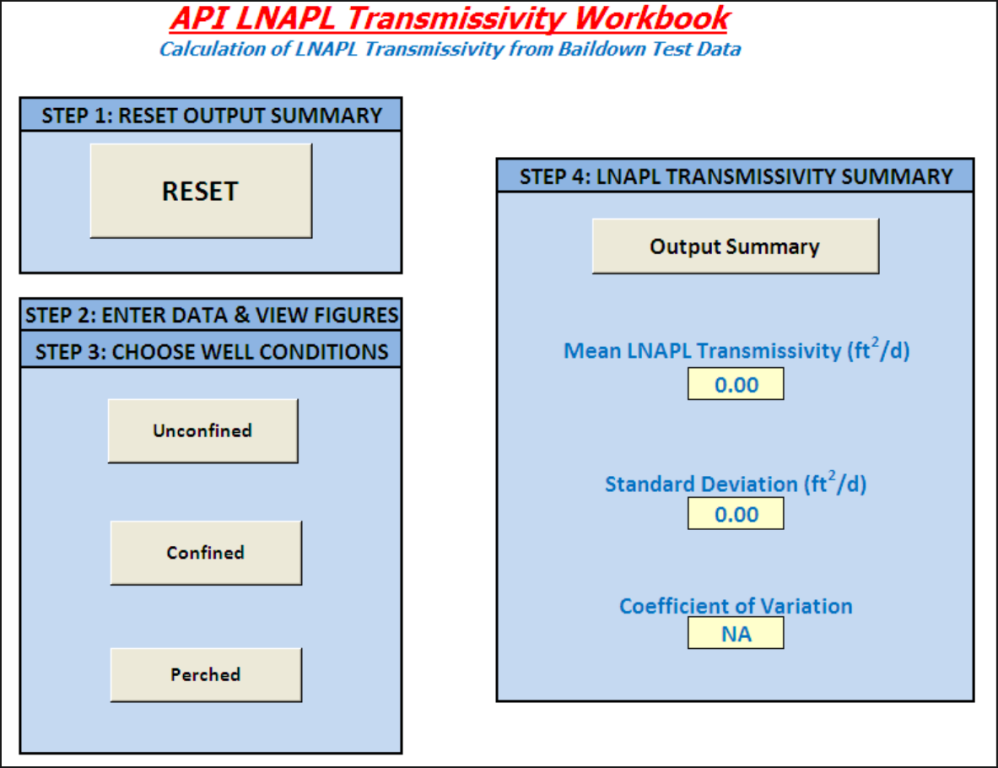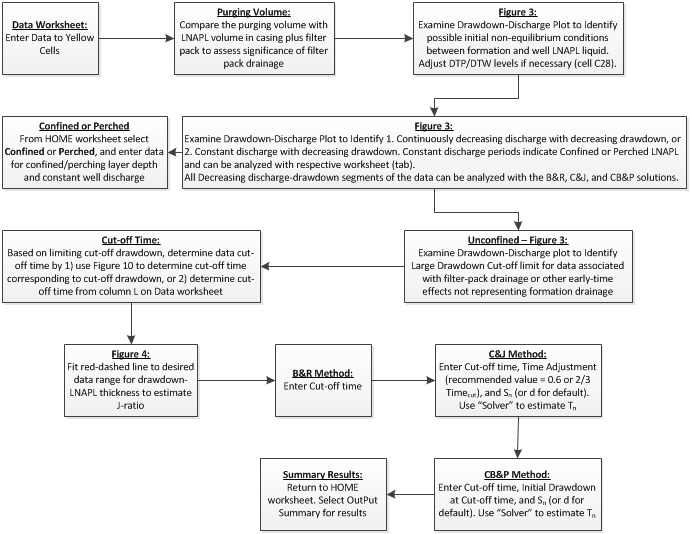Applied NAPL Science Review
Demystifying NAPL Science for the Remediation Manager
ANSR Scientific Review Board
J. Michael Hawthorne, PG, Board of Chairman, GEI Consultants Inc.
Mark Adamski, PG, BP Americas
Dr. Randall Charbeneau, University of Texas
Dr. Sanjay Garg, Shell Global Solutions (US) Inc.
Dr. Terrence Johnson, USEPA
Andrew J. Kirkman, PE, BP Americas
Mark Lyverse, PG, Chevron Energy Technology Company
Mark W. Malander, ExxonMobil Environmental Services
Dr. Rangaramanujam Muthu, H2A Environmental, Ltd.
Applied NAPL Science Review (ANSR) is a scientific ejournal that provides insight into the science behind the characterization and remediation of Non-Aqueous Phase Liquids (NAPLs) using plain English. We welcome feedback, suggestions for future topics, questions, and recommended links to NAPL resources. All submittals should be sent to the editor.
API LNAPL Transmissivity Spreadsheet:
A Tool for Baildown Test Analysis
Randall J. Charbeneau – The University of Texas
Andrew Kirkman – BP Americas
Background:
Baildown tests are a simple method for estimating LNAPL transmissivity where a volume of LNAPL is rapidly removed from a well and the rate of fluid-level recovery (water and LNAPL) is measured and analyzed. Several methods are available to analyze the data from baildown tests to estimate LNAPL transmissivity. To complement the new guide on LNAPL transmissivity published by ASTM (ASTM, 2011), API has released an Excel spreadsheet tool and supporting documentation for estimating the LNAPL transmissivity from baildown test data using one or more of several analytical methods presented in literature (https://www.api.org/environment-health-and-safety/clean-water/ground-water/lnapl.aspx).
The spreadsheet can be used to estimate the LNAPL transmissivity for unconfined, confined, and perched conditions using the field test data. For unconfined conditions, three methods are available to calculate LNAPL transmissivity. For confined or perched conditions, LNAPL transmissivity can be estimated either for an observed constant discharge period or for later-time data when LNAPL in the well is in communication with the formation LNAPL. The later time portion of the data can be analyzed using unconfined LNAPL methods.
The spreadsheet tool does not automatically estimate the transmissivity from the gauging data but requires varying degrees of user consideration with regards to the gauging data, boundary conditions, and other input parameters. However, the guidance document provides additional details and examples to support the analysis of LNAPL transmissivity for various hydrogeological conditions.
Key Features:
The API spreadsheet consists of multiple worksheets, not all of which are visible at once, depending on the analysis. The following three worksheets are visible at all times:
- Home – Control and output worksheet with a step-by-step outline for data analysis (as shown in the following figure)
- Data – Entry of well configuration and gauging data
- Figures – Ten figures presenting graphical interpretations of baildown test. Of these, four figures provide tools to significantly increase the precision and accuracy of LNAPL transmissivity estimation:
- Gauging data vs. time – provides the baildown test recharge profile and is used to identify equilibrium or non-equilibrium conditions.
- Discharge vs. Drawdown (DvD) – in conjunction with the boring log and gauging data helps identify the well conditions including periods of filter pack drainage, relationship between discharge and drawdown (linear for unconfined conditions, and constant discharge for confined/perched conditions). The Discharge- Drawdown data should extrapolate to the origin for small values. Deviations from this indicate erroneous drawdown estimates and/or initial non-equilibrium conditions.
- LNAPL Drawdown vs. LNAPL well thickness (J-Ratio Plot) – an essential diagnostic tool used to estimate the J-ratio magnitude, which is the slope of the linear relationship between LNAPL drawdown and LNAPL well thickness. This ratio is used to estimate transmissivity from the Bouwer & Rice, and Cooper, Bredehoeft and Papadopulos methods. Inaccurate or assumed estimates of the J-ratio can result in significant errors in the estimated transmissivity value.
- Gauged LNAPL thickness vs. Log time – allows the user to understand if gauged LNAPL thickness reached equilibrium.
API LNAPL Transmissivity Workbook – Home (Control & Output Worksheet)

Additional worksheets include one for each of the methods to estimate the LNAPL transmissivity for unconfined (three methods), confined (one method), and perched (one method) conditions.
Process:
The process for estimating LNAPL transmissivity from LNAPL baildown test data using the API LNAPL Transmissivity Workbook is outlined below.
Process Outline to Estimate LNAPL Transmissivity Using the API Spreadsheet

Methods:
The spreadsheet includes methods to calculate LNAPL transmissivity for unconfined, confined, or perched LNAPL hydrogeologic conditions. The sheet(s) for the appropriate method(s) are visible once the LNAPL hydrogeologic condition is identified in the “HOME” worksheet.
- Unconfined – LNAPL transmissivity is estimated using three methods, which when properly applied, can often estimate LNAPL transmissivity with coefficient of variation (ratio of the standard deviation to mean value) within 20% when considering these three methods.
- Bouwer & Rice (B&R) – This method, modified from the generalized Bouwer & Rice method, considers the logarithm of the drawdown variation as a linear function of time. A straight line is fit to this relation and the slope is used to determine the LNAPL transmissivity. Use of the J-ratio plot is required for accuracy and resolves historical boundary conditions specific to the Lundy and Zimmerman (1996) and Huntley (2000) methods.
- Cooper & Jacob (C&J) – This method provides an estimate of the LNAPL transmissivity based on the LNAPL discharge to the well and LNAPL drawdown, as a function of time. The method also requires estimation of an LNAPL storage coefficient. The LNAPL transmissivity and storage parameters are estimated by comparing the measured and calculated discharge to the well.
Cooper, Bredehoeft, and Papadopulos (CB&P) – This method provides an estimate of the LNAPL transmissivity based on measurements of LNAPL drawdown versus time. The method also requires an estimate of the LNAPL storage coefficient. The CB&P method does not directly use the LNAPL discharge to the well, and it does require an estimate of the effective initial LNAPL drawdown.
- Confined – LNAPL transmissivity for confined condition is estimated from the modified Thiem equation. The depth to base of confining bed is input to determine the effective limiting thickness of LNAPL in the well. The constant discharge from the steady discharge portion of the test is used to calculate the LNAPL transmissivity.
- Perched – The equation to estimate LNAPL transmissivity for perched condition considers the depth to the top of the perching layer. The constant discharge from the steady discharge portion of the test is used to calculate the LNAPL transmissivity.
The preceding article is an introductory primer to the API LNAPL Transmissivity Spreadsheet. Additional discussion on the boundary conditions, advantages and limitations for the three unconfined methods used to estimate the transmissivity, identifying equilibrium fluid levels from field data and other considerations will be discussed in future issues.
References:
ASTM (2011) The Standard Guide for Estimation of LNAPL Transmissivity, ASTM E2856-11.
Charbeneau, Randall J., Andrew Kirkman, and Rangaramanujam Muthu (2011) API LNAPL Transmissivity Workbook: User Guide.
Related Links
API LNAPL Resources
ASTM LCSM Guide
Env Canada Oil Properties DB
EPA NAPL Guidance
ITRC LNAPL Resources
ITRC LNAPL Training
ITRC DNAPL Documents
RTDF NAPL Training
RTDF NAPL Publications
USGS LNAPL Facts
ANSR Archives
Coming Up
Look for more articles on LNAPL transmissivity as well as additional explanations of laser induced fluorescence, natural source zone depletion and LNAPL Distribution and Recovery Modeling in coming newsletters.
Announcements
An updated version of the ASTM Guide for Calculating LNAPL Transmissivity is Now Available for Purchase at www.astm.org.
ASTM Standard E2856 – Standard guide for Estimation of LNAPL Transmissivity is now available
The ASTM LNAPL Conceptual Site Model (LCSM) workgroup is actively updating the ASTM LCSM guidance document. If you are interested in participating on this team or would like to send comments for consideration – please contact Andrew Kirkman of BP Americas (team leader).
ANSR now has a companion group on LinkedIn that is open to all and is intended to provide a forum for the exchange of questions and information about NAPL science. You are all invited to join by clicking here OR search for “ANSR – Applied NAPL Science Review” on LinkedIn. If you have a question or want to share information on applied NAPL science, then the ANSR LinkedIn group is an excellent forum to reach out to others internationally.
